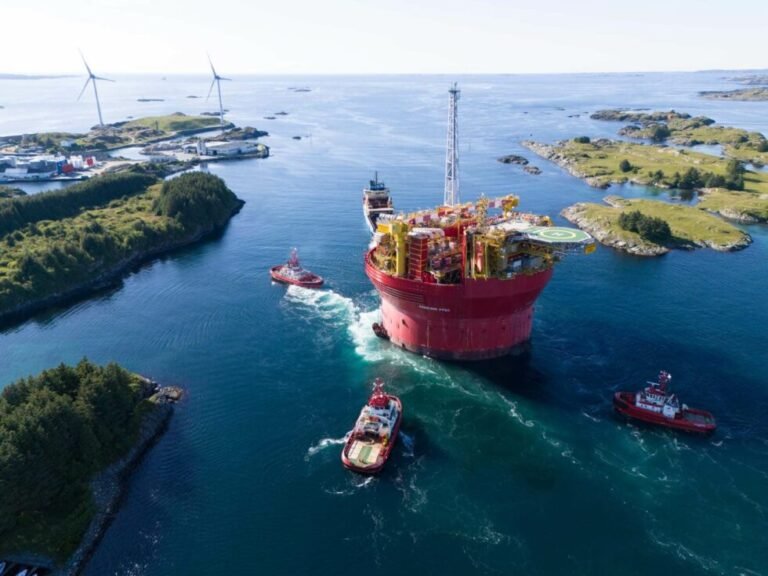Shell Commences Operations of New FPSO in the North Sea
UK-headquartered energy giant Shell has put into operation mode its first new floating production, storage, and offloading (FPSO) vessel in the North Sea after more than two decades have gone by since the installation of its previous one. This unit enables the firm to restart oil and gas production from a field that has been offline since 2021.
Shell took a final investment decision (FID) on the redevelopment of the Penguins oil and gas field in 2018, authorizing the construction of the FPSO Penguins, which is the first new installation for the UK-headquartered player in the northern North Sea in almost 30 years. The unit was installed at the Penguins field in July 2024, with Sevan SSP assisting with the design, preparations, and execution of the FPSO transport and installation.
This vessel, which features a Sevan 400 design with a process capacity of 45 kbbld and a storage capacity of 400 kbbls, has been contracted by Fluor and constructed in China, with completion and commissioning at Aibel’s yard in Haugesund, Norway, before being handed over to Shell.
Restoring Production in the UK North Sea
The FPSO, constructed by China’s Offshore Oil Engineering Company (COOEC), has now started its assignment in the UK North Sea, 241 kilometers (150 miles) northeast of the Shetland Islands, restoring production from the Penguins field, which stopped when the previous export route for this field via the Brent Charlie platform was no longer viable as the asset ceased production in 2021 and is being decommissioned.
Shell is the operator of the Penguins field with a 50% stake, and its partner, NEO Energy, holds the remaining 50% interest. The peak production is estimated to be around 45,000 barrels of oil equivalent per day (boe/d). This asset currently has an estimated discovered recoverable resource volume of approximately 100 million boe.
Zoë Yujnovich, Shell’s Integrated Gas and Upstream Director, commented: “Today, the UK relies on imports to meet much of its demand for oil and gas. The Penguins field is a source of the secure domestic energy production people need today, and the FPSO is a demonstration of our investment in competitive projects that create more value with less emissions.”
Environmental Impact and Operational Efficiency
Even though the field will primarily produce oil, the operator claims that it will also enable enough gas to heat around 700,000 UK homes per year. The new FPSO is anticipated to have around 30% lower operational emissions compared with Brent Charlie, extending the life of the field by up to 20 years.
While natural gas will be transported through the existing pipeline to the St Fergus Gas Terminal in the northeast of Scotland, which supplies the UK’s national gas network, oil will be transported by tanker to refineries outside of Britain. However, Shell underlines that these entail ones that supply refined products like petrol and diesel back to the UK because of its limited refining capacity.
The operator confirms that the redevelopment of the Penguins field encompassed drilling additional wells, which are tied back to the new FPSO. The field lies at 165 meters (541 feet) of water depth, around 150 miles northeast of the Shetland Islands. Discovered in 1974, the field previously produced oil and gas between 2003 and 2021.
Future Plans and Sustainability Commitment
Designed by Sevan, a Norwegian technology, design, and engineering company, the FPSO Penguins is a compact facility with a cylindrical hull design, which is said to provide more efficiency and flexibility. The unit has a flareless system, which recycles vapor back into the tanks and curbs emissions.
The FPSO Penguins is a 118-meter-tall vessel, which is equivalent to a 42-story residential building. It can withstand harsh sea conditions and weighs 32,000 metric tons. The FPSO can process 12.75 million barrels of crude oil and 1.24 billion m3 of natural gas per year. It has a maximum crude storage capacity of 400,000 barrels.
As Shell is committed to delivering upstream and integrated gas projects coming on stream between 2023 to 2025 with a total peak production of greater than 500,000 barrels of oil equivalent per day, Penguins is expected to contribute to this commitment.
The firm, which has set a target to become a net-zero emissions energy business by 2050, achieved by the end of 2023 more than 60% of its target to halve emissions from its operations (Scopes 1 and 2) by 2030, compared with 2016.
Shell is investing not only $10-15 billion in low-carbon energy solutions between 2023 and the end of 2025 but also about $13 billion a year for oil and gas developments with a focus on LNG, adding up to potentially over $100 billion in total by 2030.
Strategic Partnerships and Industry Developments
Moreover, Shell and Equinor set the wheels in motion to combine their UK offshore oil and gas assets and expertise in December 2024 to form a new company which they claim will be the UK North Sea’s biggest independent producer.
Upon completion, the new independent producer will be jointly owned by Equinor (50%) and Shell (50%), taking on Shell’s equity interests in Penguins. A recent court ruling overturned the previous UK government’s decision to approve Shell’s Jackdaw in the North Sea and Equinor’s Rosebank located west of the Shetland Islands, outlining that the government failed to consider the emissions that would be caused by burning the oil and gas produced by these fields.
While the court’s decision allows the work on Jackdaw and Rosebank to continue, the energy players will need to reapply for consent to develop these untapped oil and gas fields and include a Scope 3 emissions assessment for each project.

